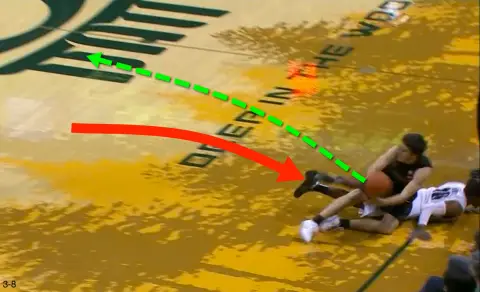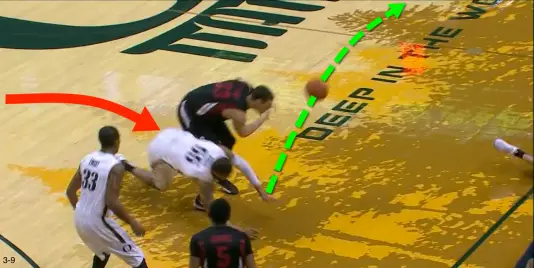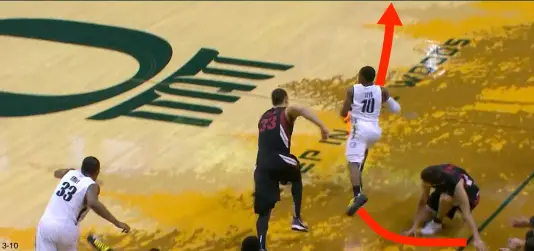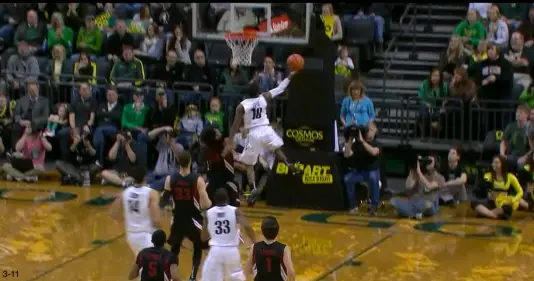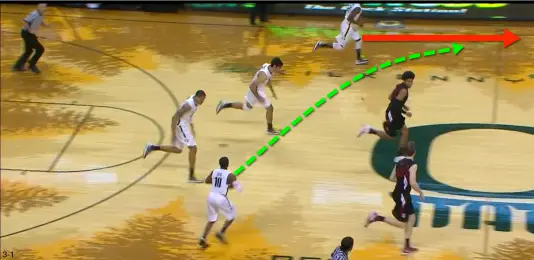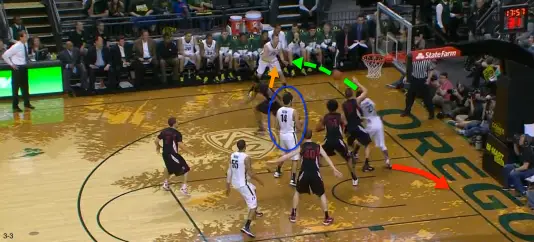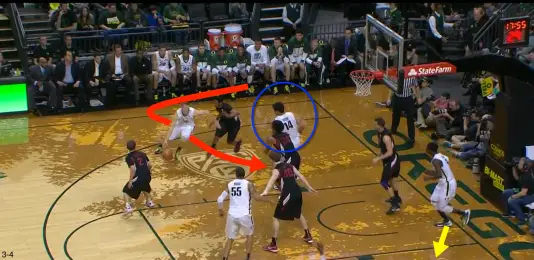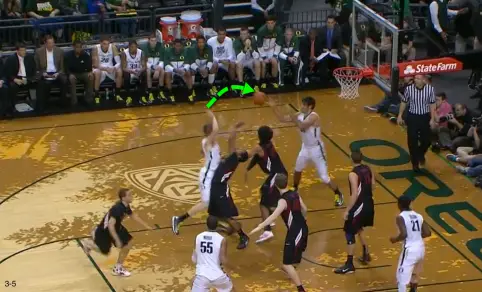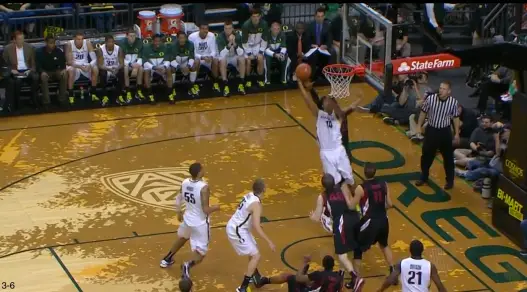Until Oregon’s recent payback win over Stanford, when the Ducks shot 48% from the field, its outside shooting woes and stagnant offensive production have been well-chronicled, especially in the nine-game absence of point guard Dominic Artis.
The offensive scouting report on Oregon? “Pay close attention to Singler, Dotson, and Emory on the perimeter, but dare Loyd and everybody else to shoot it. Keep track of Kazemi, but he won’t shoot outside six feet. Sag in the middle to clog it up and don’t allow them to use their athleticism to drive to the hoop. Deny deep post-entry passes, and double-team the ball inside the key. Keep them off the glass!”
Stanford initiated this defensive plan with great results a month ago in Palo Alto, and every team Oregon has faced since has tried some version of it with various degrees of success. That is, until Jonathan Loyd went off for his best game of the season in the rematch against the Cardinal last week.
While one might bemoan the recent offensive struggles of this squad, one thing is very clear. This Oregon team can play defense. With one exception (the Stanford loss), the Ducks have defended at a high level every night out. It is the main reason that Oregon stands in first place in the Pac-12 with three games to go. It has kept them in games when the ball simply wouldn’t go in the hole.
Loyd and Woods team up for a steal and score: I want to illustrate a remarkable play that occurred midway through the second half, right after Stanford star Dwight Powell returned to the game with four fouls as the Ducks were steadily pulling ahead. It represents the determination and effort that was evident all game and it revved up the sold-out Matt Knight Arena to a feverish pitch.
(Above): With Stanford on offense, Loyd reaches in and knocks the ball loose from Christian Sanders and it rolls toward the sideline (green dotted arrow).
(Above): Loyd dives headfirst out of bounds as he attempts to recover the ball (red arrow), but Sanders flips it back into the court (green dotted arrow). Note Loyd’s prone position, because he pops up instantly and hustles back on the court to help finish the play.
(Above): Tony Woods dives to the floor (red arrow) and collides with Powell, but manages to deflect the ball off Powell toward the Oregon basket and right into Loyd’s hands (green dotted arrow).
(Above): Wood’s hustle was rewarded as Loyd catches the tipped ball in the air and heads for the other end (red arrow).
(Above): The 5’7″ Loyd takes the ball the length of the court for a big-time finish over Stanford’s 6’7″ Josh Huestis. The bucket gave Oregon a 12-point lead in the game. From there, it was all Oregon.
Coach Dana Altman said, “That was a big play in the game. Any coach likes seeing his players go to the floor to get a loose ball. It’s a stat that’s not kept, but it’s big. To see ‘Big Tone’ dive after it–it’s always good to see that kind of effort. And I know our fans appreciate it.”
Oregon dominated the second half of the game. The Ducks turned the contest into a lopsided affair by out-hustling and overwhelming the Cardinal, collecting 12 steals and forcing 17 turnovers (for the game), while scoring 25 points as a result. Their high level of intensity on defense completely did in Stanford, which in turn, allowed Oregon to run free and easy and play transition basketball, attacking the hoop, kicking the ball out to the perimeter, and then attacking the basket again by making natural, instinctive basketball plays without setting up in a prescribed play. The Ducks took full advantage.
Altman said, “Points off turnovers is always a big stat that we look at. It’s one that’s very telling, when you look at the win-loss column. When we’ve been able to get the other team to turn it over, we have had much better success. There’s no doubt about that.”
Running the Break in Transition: The second play that I’m going to illustrate also came in the second half of the Stanford win. It is an example of Oregon having offensive success without actually setting up an offensive set. It shows that you don’t have to score directly on the break to still make instinctive plays that bring a successful result.
(Above): After receiving the outlet from Woods, who rebounded a Stanford missed shot, Loyd passes quickly (green dotted arrow) to a streaking Damyean Dotson on the left sideline (red arrow).
(Above): Dotson takes the ball hard down the sideline and attacks the basket from the wing (red arrow). Note Singler in the corner (yellow circle). He becomes a passing target for Dotson.
(Above): After Dotson’s drive to the hoop was thwarted, he passes to Singler, who is open in the corner (dotted green arrow). Singler’s defender closes quickly (orange arrow). After passing, Dotson will move to rebounding positon (red arrow). Note Arsalan Kazemi (blue circle), who becomes open when his man goes to help on defense.
(Above): When Chasson Randle closes out too hard on Singler in the corner, he promptly goes by him and attacks the hoop (red arrow). Dotson moves to rebound (yellow arrow), and Kazemi’s man (blue circle) moves to stop Singler, leaving Kazemi wide open.
(Above): When his drive to the hoop runs into into a double-team, Singler alertly drops the ball over Huestis to a wide-open Kazemi (green dotted arrow).
(Above): Kazemi finishes the easy score for one of his 15 points on the pass from Singler as the Ducks continued to roll.
“We want to score any way we can, and transition’s been very good to us,” Altman said.
Altman likes the competitiveness of this team and credits that spirit in his players with the success of this year’s squad. He said, “They’re a competitive group. There’s one characteristic you can’t give a team, and that’s competitiveness. They’ve got to bring that and learn to compete day in and day out at practice. It’s a characteristic that’s really underestimated. Everybody looks at talent and jumping ability. All those God-given abilities are important, but if you can’t bring a certain degree of competitiveness at this level, you have no chance to be a good player and we have no chance to be a good team. I think this group has competed very well.”
After 28 games, this team has proven that competing on the defensive end gives them a chance every night. As tournament time approaches, that’s a comforting thought.
Related Articles:
Seven Offensive Coordinator Candidates for the Oregon Ducks
Five Candidates to Replace OC Marcus Arroyo
Coach Jim Mastro: The Perception, and the Truth
Has Oregon Turned the Corner on Offense?
Ducks, Taggart Punish Beavers; Earn Bowling Trip
Textbook Defense, Herbert's Return Energize Duck Victory; Civil War Next
Luke Roth (Basketball Analyst) is a retired teacher and coach who has lived in Eugene since 1977. He coached high school basketball for 34 years, including 26 years as Sheldon HS girls varsity basketball coach (1984-2010). Luke taught at Sheldon for 30 years, and in the International HS at South and Sheldon, for 20 years. He taught journalism and advised the school newspaper at Sheldon during his stint there. He is a long-time Duck fan and UO alum (MA 1985). Luke has been married to his wife Catherine for 36 years with two grown children and one eight-year-old grandson. In retirement, Luke spends his time hiking, biking, gardening, writing, and playing the stand-up bass in the Sorrel Way Jam. Follow Luke on Twitter: @luke_lukeroth



